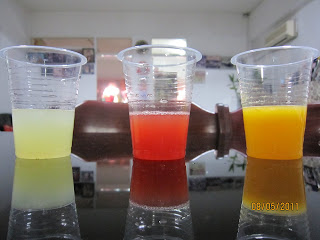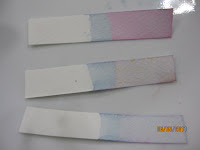In term 3, we learnt about cells, diffusion and osmosis, digestive system and photosynthesis.
Cell is something which we had learnt before in primary school. And what is taught in secondary school is more detailed and distinct differences and similarities were also highlighted. Before progressing into the actual learning of the cells, we must first know how to draw them. Ms Nada spent a lesson going through with us on how to draw a proper cell. It dawned upon us that drawing cells is not child’s play and we need to be very precise in our drawing. For example, when drawing a circle, the point in which one starts to draw and ends up on cannot be distinguished. There were also guidelines regarding the labeling of cell parts. After that, we officially started the learning of cells. We were introduced more parts of a cells such as mitochondrion, ribosome, the smooth and rough endoplasmic reticulum and the golgi apparatus. The exposure to more parts of a cell lets us better understand how a cell function and survive. Knowing that there are many different parts of the cell which enables it to survive, it links us to the division of labor in cells. As each part of a cell performs a specific function, how would this ensure the survival of the particular organism? We were told to think about this question. For our science practical, we were supposed to observe the surface of onion peels and our cheek cells under a microscope. Apart from learning how to properly use a microscope, which was important, we also learned how to properly place the samples in between a plastic sheet. We have to place it down slowly at an angle to prevent trapping air bubbles. To ensure that we can clearly see the specimen, iodine was added. While scraping off the cheek cells, we have to ensure that we do not apply too much force or else we would end up observing blood cells under the microscope.
Diffusion and osmosis was what we learnt next. This topic is highly related to the next topic which we will be learning- Digestive system. In diffusion, it is always from more to less. Which means that particles move from a more concentrated region to a less concentrated region. In real life, one of the examples in which diffusion is carried out is the exchange of gases when we breathe. In osmosis, the movement of particles is from one place of high water potential to one of lower water potential.
Next, we learnt about the digestive system. Firstly, we started off by learning about the individual parts of the digestive system, together with their functions and the enzymes they contain. These enzymes aid in digestion and they aid in the absorption of food as they speed up the rate of chemical reaction and food particles could enter the bloodstream in a shorter amount of time. Ms Nada did a practical with us about the “artificial intestines”. Visking tubing filled with a solution of starch and glucose placed in a test tube of water. After some time, only the presence of glucose could be detected in the water. It is assumed that the starch particles are too huge to pass through the visking tubing, while the glucose particles are small enough diffuse out of the visking tubing. This practical let us better understand the workings of our digestive system and the way food can be absorbed into our bloodstream.
 |
| Digestive System |
Our last topic for the term is photosynthesis. Photosynthesis is not new to us, as we have learnt the basics in Primary school. Apart from learning the process of photosynthesis, such as what must be present for it to take place and what is produced, we also learn how to conduct a practical to find out if a leaf contains chlorophyll. Firstly, we took variegated leaf and boil it in water for 2 mins. This is to break the cell structure of the leaf. Switch off the Bunsen burner. Next, we place the leaf in 20ml of methylated spirits in a beaker. The beaker which contains the leaf and the methylated spirits is then placed into the beaker of hot water. After some time, the methylated spirit will turn green. Chlorophyll solution is now in the methylated spirit. After that, remove the leaf from the beaker and place it on a white tile. Add a few drops of iodine solution.The green region of the leaf will turn blue black while the non green region will turn brown. Therefore, it can be concluded that the non green region does not contain starch while the green region contains starch.
Picture of plant cell and animal cell from:
http://leavingbio.net/Cell Structure_files/Cell Structure_files/image023.jpg
Picture of Diffusion from:
https://blogger.googleusercontent.com/img/b/R29vZ2xl/AVvXsEj0_ktb6PsoY7LoXSxphPSSqct7gYoPkEvl2eWtGLSVTHl4sgRXP1Y8i4uAz8NGEdiEVhmBY8YVM8oeW2mUyEJQ-ydyB84fHWYCJEYX_QD1j0kfxsugJSDaKYCcIXcFazKKWwhJKuviNwQ/s1600/diffusion+pic.gif
Picture of Osmosis from:
https://blogger.googleusercontent.com/img/b/R29vZ2xl/AVvXsEh5mNKKwvyhMvbKHTFHFSNhDm2Ct8zitNWUQVWWhXuduUrYsxBEq4SxgL3IyQJ3ScCWmQjcjMyCau9RglLMS3ShT-PYUXYw_L_6usu09ApyVoTTwNPlwb3aHN5-3Cki-XhXuODZPvhMuTs/s1600/osmosis.gif
Picture of Digestive System:
https://blogger.googleusercontent.com/img/b/R29vZ2xl/AVvXsEjhT61dDW6RQp0RsUR4pA9WlGIGL6LQ6GGCN6htGeLDYYiZkS_gDtMo69wqMu-6FHl4lmdAwuI8BgnVlMzxNz2fEhdOiwsbXm-c8HGe1SGcGU76EoKtRrNqi2oyMsI9IiuCCU1ZTjCyqbI/s1600/Digestive+system+for+human++Digest.gif
Picture of Enzyme Example:
https://blogger.googleusercontent.com/img/b/R29vZ2xl/AVvXsEjhT61dDW6RQp0RsUR4pA9WlGIGL6LQ6GGCN6htGeLDYYiZkS_gDtMo69wqMu-6FHl4lmdAwuI8BgnVlMzxNz2fEhdOiwsbXm-c8HGe1SGcGU76EoKtRrNqi2oyMsI9IiuCCU1ZTjCyqbI/s1600/Digestive+system+for+human++Digest.gif


























